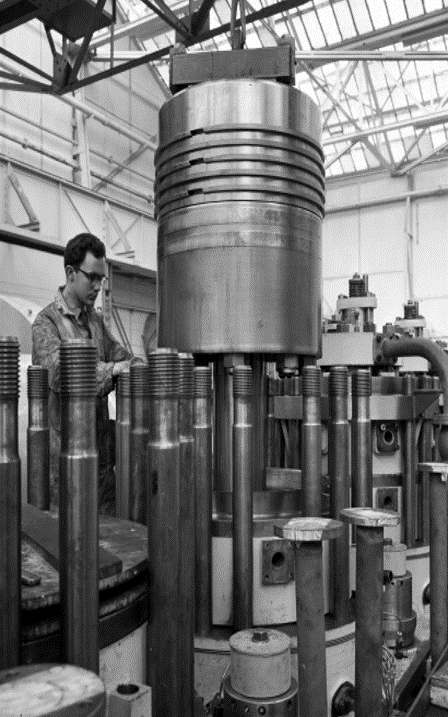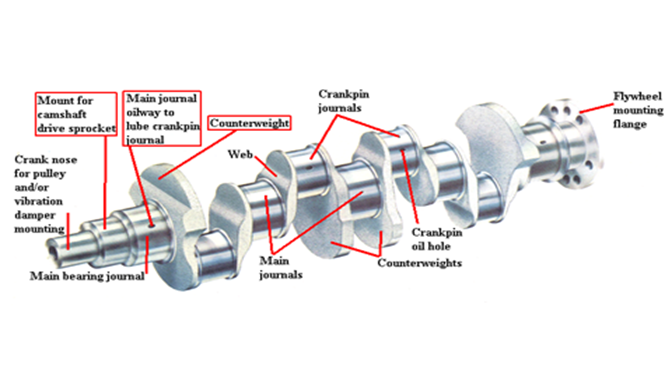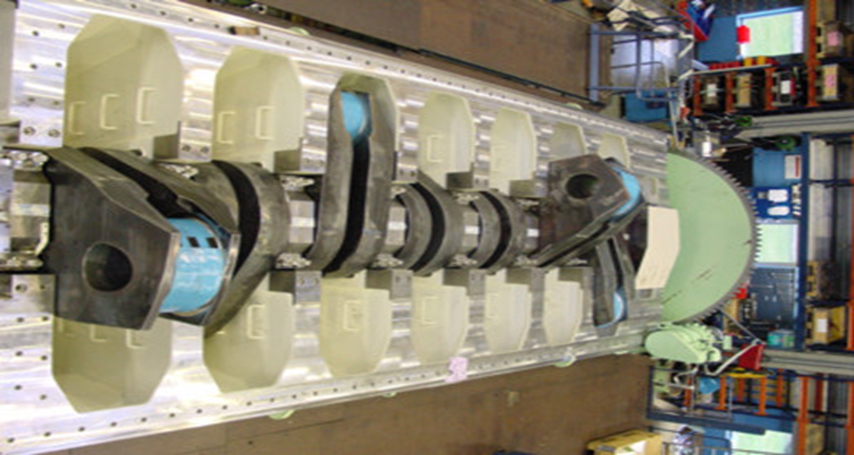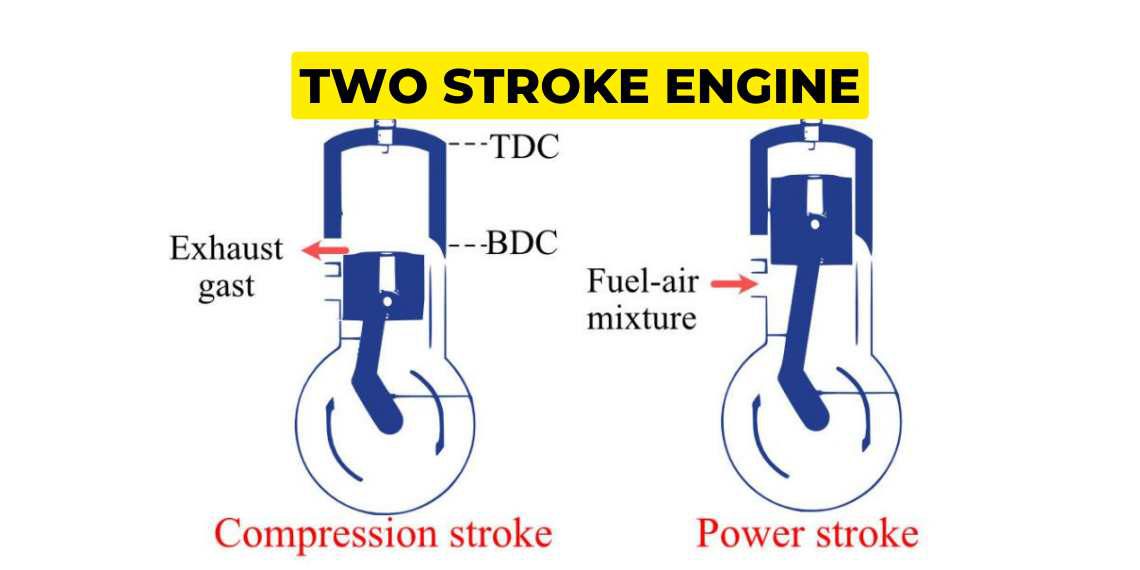Two-stroke engine and its parts
A two-stroke engine is a type of internal combustion engine that completes a power cycle with two strokes (or movements) of the piston within a single rotation of the crankshaft. It is commonly used in small engines for applications such as motorcycles, scooters, chainsaws, outboard motors, and some recreational vehicles.
Unlike a four-stroke engine that has separate intake, compression, power, and exhaust strokes, a two-stroke engine combines these functions into two strokes: the compression/exhaust stroke and the power/intake stroke. This design makes the two-stroke engine simpler and lighter than a comparable four-stroke engine.
Strokes involved are:
- Upstroke/Compression stroke (Scavenge/Compression): In this stroke, the piston goes from BDC to TDC and scavenging takes place (air comes inside the cylinder when the piston is at BDC and exhaust gas goes out), fresh air takes the place of the exhaust gases so that it can get compressed and mix with fuel.
- Downstroke/Power stroke (Expansion/Exhaust): In this stroke, compressed fuel is ignited and the expansion takes place, giving the power cycle. When the piston goes down at a certain point the exhaust valve opens and the exhaust gases go out.

Parts of a two stroke engine:
PISTON:
A piston is one of the most important parts of the combustion chamber which transmits the expanding gas forces to the connecting rod therefore mechanical power can be generated because of reciprocating motion of the piston.
Function of piston: The function is same for two stroke and four stroke engines. It seals the combustion chamber, transmit gas load to the connecting rod.
Parts:
- Piston crown – it is the top part of the piston exposed to very high pressure and temperature.
- Piston skirt – lower part of the piston, which transmits side thrust to the liner in a four stroke engine.
- Piston rod – Connects piston to crosshead in two stroke engine, it is not available in four stroke engine.
Material:
- Crown – Aluminium or cast steel in four stroke engine or cast chrome nickel molybdenum alloy steel in two stroke engine.
- Shirt – Cast iron or SI Aluminium alloy
- Rod– Forged steel

PISTON RINGS:
Piston rings are usually 4 compression rings and 1 oil Scraper rings [ NOTE: there are no oil scraper rings in 2 stroke engine.
COMPRESSION RINGS: Their purpose is to prevent blow past, that is to provide effective sealing of the combustion space by expanding.
Material: CAST IRON with alloys of chromium, Vanadium, titanium, molybdenum, nickel and copper.


CYLINDER LINER
It is the most important part of an IC engine inside which the piston reciprocates smoothly.
Function:
- Provide area for cooling, lubrication, scavenging
- Assist in sealing the combustion chamber.
Material: Pearlitic grey cast iron – contains vanadium and titanium to give strength and increase wear resistance, reducing corrosion.

STUFFING BOX:
Stuffing box is fitted in a large crosshead type engine, consisting of several sets of sealing and scraping rings. Piston rod actually passes through the stuffing box and is fitted only in a two stroke engine.
Function:
- Separate the scavenge space and crankcase
- Prevent scavenge air entering into crankcase
- Prevent mixing of crankcase oil and cylinder oil
Material: Rings: made of bronze or cast steel
Housing: made of cast iron/ cast steel

CONNECTING ROD
In a two stroke engine it is fitted between cross head and crankshaft.
Function:
- Transmit reciprocating motion of the piston into rotary motion of the crankshaft.
- Also provide space for bearings.
Material: Mild or medium steel

CROSS HEAD BEARING:
Cross head bearing is provided in two stroke slow speed Marine Diesel Engine.
Function:
- connects piston rod foot with the connecting rod
- absorbs side thrust and then transmits it to engine frame
- acts as a bearing, allows connecting rod to swing smoothly
- using a crosshead we can achieve long strokes.
Material: Tin-al-white metal thin shell bearing.

CYLINDER HEAD ASSEMBLY:
Cylinder head assembly is one of the most important components of combustion space, it has bore for mountings like indicator cock, inlet and exhaust valves, fuel injector, air starting valve and rocker arm assembly.
Function: To close the end of the cylinder and seal in the gases as they undergo a cycle involving extreme pressure and temperature.
Material: Head cover- cast iron

EXHAUST VALVE:
Exhaust valve is the hot exhaust gas from the cylinder unit is expelled out through the exhaust valve during the exhaust cycle and further the gas goes to the exhaust manifold, they are two in number for the generator engine, while the main engine has one exhaust valve.
Material: Coating of stellite/nimonic
Exhaust valve seat: mild steel with stellite coating
Exhaust valve cage: perlite cast iron
Spindle: Nimonic

FUEL INJECTOR:
Fuel Injector is one of the most important cylinder head mounting, which is responsible for good atomisation and penetration of the fuel.
Function: To provide the right amount of pressurised fuel at the right moment for good combustion.

INDICATOR COCK:
Indicator cock is one of the cylinder head mounting, which is opened for a few seconds before the fuel injection to blow out the condensate or any debris out of the cylinder.
NOTE: While engine is running it must be in shut condition
Function:
- To blow out the condensate (as liquid is incompressible, if it is not removed then it can damage the moving parts)
- Used to calculate the indicated power of the engine.

AIR STARTING VALVE:
Air starting valve is fitted on each cylinder head to supply 30 bars of air into the engine for cranking the engine.
Function:
- It is responsible to start the engine from standstill or stop position.
- Additionally, it assists in reversing the engine or performing emergency stopping (crash maneuvering) of the engine.
Material:
Body – Mild steel
Spindle – High tensile steel
Valve seat – Stellite hardened tensile steel

SCAVENGE PORTS:
Scavenge or scavenging port refers to that port through which clean air enters the cylinder.
Function: replace the exhaust gas in a cylinder with the fresh air for the next cycle.
Material: Cast Iron

CRANKSHAFT:
In Marine engine the crankshaft is a shaft, which transfers power to rotate the propeller in two stroke and to drive the alternator in a four stroke engine.
Function: Converts the oscillating motion of the con rod / reciprocating motion of the piston to rotary motion of the shaft.
Material: High carbon steel


CAMSHAFT AND CAMS:
Camshaft can be of single or several units.
In two stroke engine crankshaft to camshaft ratio = 1:1
In four stroke engine crankshaft to camshaft ratio = 2:1
Function:
In two stroke engine – 2 cams per unit (to operate fuel pump and exhaust valve only)
In four stroke engine – 3 cams per unit (to operate fuel pump, exhaust and inlet valve)
Material: Hardened alloy of iron or steel.

BEDPLATE: It is the “Base or Foundation of the engine”
which carries the other components of the engine structure.
Function: To support crankshaft and it will withstand
high inertia loads of moving parts.
Material:
Cast iron: Absorbs and dampen vibration
Mild Steel: Greatest strength against shock load

ENGINE FRAME or A FRAME:
The engine frame is also referred to as an “A-frame” because it bears a resemblance to the letter ‘A’ in its shape.
Function: They are used to support the cylinder
block in 2 stroke Marine Diesel engine.
Material: Fabricated Mild Steel Plate

ENTABLATURE:
Entablature is a part of ship’s main engine, it is a name given to Cylinder block.
Function: Which incorporates the scavenge
air space and cooling water space. It forms housing
to take the cylinder Liner.
Material: Cast Iron

TIE RODS
The Entablature, A frame and bed plate are held together by long tie rods.
Function: It keep the whole engine structure under compression and transmit firing loads to the bed plate.
Material: Mild steel

Note
If you want to learn more about this topic, we suggest checking out our Combo package with the given link https://www.merchantnavydecoded.com/courses/c/ . It’s a great way to dive deeper into the subject through video explanations. This package covers all the important details and presents them in an easy-to-understand format. Watching the videos will help you grasp the topic better and make learning more enjoyable. So, we highly recommend giving our Combo package a try to enhance your knowledge on the subject.
Disclaimer :- The opinions expressed in this article belong solely to the author and may not necessarily reflect those of Merchant Navy Decoded. We cannot guarantee the accuracy of the information provided and disclaim any responsibility for it. Data and visuals used are sourced from publicly available information and may not be authenticated by any regulatory body. Reviews and comments appearing on our blogs represent the opinions of individuals and do not necessarily reflect the views of Merchant Navy Decoded. We are not responsible for any loss or damage resulting from reliance on these reviews or comments.
Reproduction, copying, sharing, or use of the article or images in any form is strictly prohibited without prior permission from both the author and Merchant Navy Decoded.



[…] is the process of removal of exhaust gases from the cylinder with adding fresh air in […]